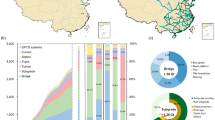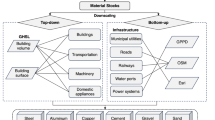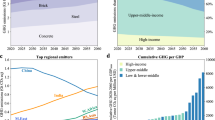Abstract
There is a rapidly unfolding sand supply crisis in meeting growing material needs for infrastructure. We find a ~45% increase in global building sand use from 2020 to 2060 under a middle-of-the-road baseline scenario, with a 300% increase across low-and-lower-middle-income regions and a slight decrease in higher-income regions. Half of this demand may be avoidable using several material efficiency strategies in concert. International cooperation is essential for addressing vulnerabilities and inequalities.
This is a preview of subscription content, access via your institution
Access options
Access Nature and 54 other Nature Portfolio journals
Get Nature+, our best-value online-access subscription
$29.99 / 30 days
cancel any time
Subscribe to this journal
Receive 12 digital issues and online access to articles
$119.00 per year
only $9.92 per issue
Buy this article
- Purchase on Springer Link
- Instant access to full article PDF
Prices may be subject to local taxes which are calculated during checkout


Similar content being viewed by others
Data availability
This research relies entirely on publicly available data as referenced. We have also deposited them in the Zenodo repository21 in a form that can be easily used with our model code. Source data are provided with this paper.
Code availability
The python code of the building sand model is publicly available from the Zenodo repository21.
References
Global Material Resources Outlook to 2060 (OECD, 2019).
Hertwich, E. et al. Resource Efficiency and Climate Change: Material Efficiency Strategies for a Low-Carbon Future (UNEP, 2020).
Huang, B. et al. Building material use and associated environmental impacts in China 2000–2015. Environ. Sci. Technol. 52, 14006–14014 (2018).
Zhong, X. et al. Global greenhouse gas emissions from residential and commercial building materials and mitigation strategies to 2060. Nat. Commun. 12, 6126 (2021).
Ioannidou, D., Nikias, V., Brière, R., Zerbi, S. & Habert, G. Land-cover-based indicator to assess the accessibility of resources used in the construction sector. Resour. Conserv. Recycl. 94, 80–91 (2015).
Torres, A., Brandt, J., Lear, K. & Liu, J. A looming tragedy of the sand commons. Science 357, 970–971 (2017).
Bendixen, M., Best, J., Hackney, C. & Iversen, L. L. Time is running out for sand. Nature 571, 29–31 (2019).
Torres, A. et al. Sustainability of the global sand system in the Anthropocene. One Earth 4, 639–650 (2021).
Krausmann, F. et al. Growth in global materials use, GDP and population during the 20th century. Ecol. Econ. 68, 2696–2705 (2009).
Ioannidou, D., Sonnemann, G. & Suh, S. Do we have enough natural sand for low‐carbon infrastructure? J. Ind. Ecol. 24, 1004–1015 (2020).
Koehnken, L. & Rintoul, M. Impacts of Sand Mining on Ecosystem Structure, Process & Biodiversity in Rivers (WWF International, 2018).
Sand and Sustainability: Finding New Solutions for Environmental Governance of Global Sand Resources (UNEP, 2019).
Stehfest, E., van Vuuren, D., Bouwman, L. & Kram, T. Integrated Assessment of Global Environmental Change with IMAGE 3.0: Model Description and Policy Applications (Environmental Assessment Agency, 2014).
Deetman, S. et al. Modelling global material stocks and flows for residential and service sector buildings towards 2050. J. Clean. Prod. 245, 118658 (2020).
Sverdrup, H. U., Koca, D. & Schlyter, P. A simple system dynamics model for the global production rate of sand, gravel, crushed rock and stone, market prices and long-term supply embedded into the WORLD6 model. BioPhys. Econ. Resour. Qual. 2, 8 (2017).
Bendixen, M. et al. Promises and perils of sand exploitation in Greenland. Nat. Sustain. 2, 98–104 (2019).
Kirthika S., Singh, S. & Chourasia, A. Alternative fine aggregates in production of sustainable concrete—a review. J. Clean. Prod. 268, 122089 (2020).
Den Hertog, J. A. Review of Economic Theories of Regulation (Tjalling C. Koopmans Research Institute, 2010).
Pauliuk, S. & Heeren, N. ODYM—An open software framework for studying dynamic material systems: principles, implementation, and data structures. J. Ind. Ecol. 24, 446–458 (2020).
Marinova, S., Deetman, S., van der Voet, E. & Daioglou, V. Global construction materials database and stock analysis of residential buildings between 1970–2050. J. Clean. Prod. 247, 119146 (2019).
Zhong, X., Deetman, S., Tukker, A. & Behrens, P. Increasing material efficiencies of buildings to address the global sand crisis, GloBus (v1.0). Zenodo https://doi.org/10.5281/zenodo.5897264 (2022).
Acknowledgements
X.Z. acknowledges the support of the China Scholarship Council (grant no. 201806050096).
Author information
Authors and Affiliations
Contributions
X.Z. and P.B. designed the research. X.Z. and S.D. developed the model and collected the data. X.Z. performed the analysis. X.Z. and P.B. drafted the manuscript. A.T. and S.D. contributed to reviewing and editing.
Corresponding author
Ethics declarations
Competing interests
The authors declare no competing interests.
Peer review
Peer review information
Nature Sustainability thanks Zhi Cao and Chris Hackney for their contribution to the peer review of this work.
Additional information
Publisher’s note Springer Nature remains neutral with regard to jurisdictional claims in published maps and institutional affiliations.
Supplementary information
Supplementary Information
Supplementary methods, discussion, Figs. 1–5, Tables 1–6 and references.
Source data
Source Data Fig. 1
Data behind Fig. 1.
Source Data Fig. 2
Data behind Fig. 2.
Rights and permissions
About this article
Cite this article
Zhong, X., Deetman, S., Tukker, A. et al. Increasing material efficiencies of buildings to address the global sand crisis. Nat Sustain 5, 389–392 (2022). https://doi.org/10.1038/s41893-022-00857-0
Received:
Accepted:
Published:
Issue Date:
DOI: https://doi.org/10.1038/s41893-022-00857-0
This article is cited by
-
Centennial evolution of Hong Kong 1910–2050: a building material metabolism perspective
Energy, Ecology and Environment (2024)
-
Development patterns, material metabolism, and greenhouse gas emissions of high-speed railway in China
Communications Earth & Environment (2023)
-
Impact assessment of river sand resource shortage under different policy scenarios in China
Low-carbon Materials and Green Construction (2023)
-
Efficient use of cement and concrete to reduce reliance on supply-side technologies for net-zero emissions
Nature Communications (2022)
-
Material efficiency to tackle the sand crisis
Nature Sustainability (2022)



